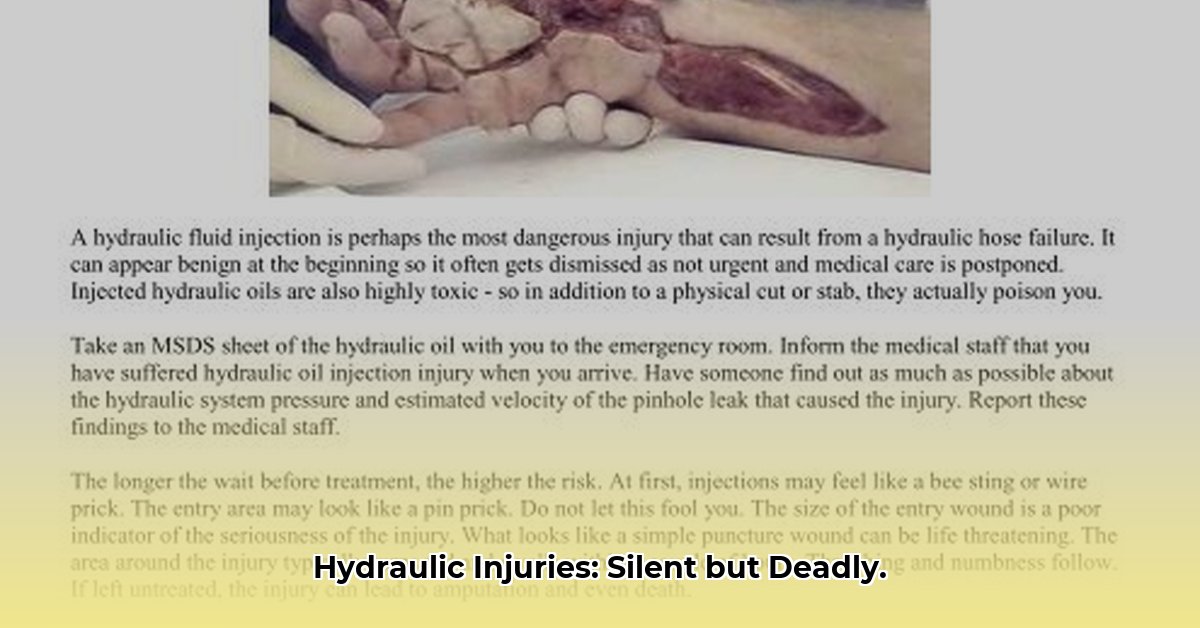Understanding the Hidden Danger of Hydraulic Injection Injuries
Imagine a seemingly insignificant pinprick, barely noticeable, perhaps dismissed as a minor scratch. Now, envision that tiny opening becoming a conduit for high-pressure fluid—oil, grease, paint, or even water—to invade your body’s tissues. This, unfortunately, describes a hydraulic injection injury, a deceptive wound with the potential for devastating internal damage. While the external injury may appear minor, the internal damage can spread rapidly, compromising nerves, tendons, muscles, and blood vessels.
Causes and Mechanisms: How These Injuries Occur
Hydraulic injection injuries typically result from equipment malfunction or misuse involving high-pressure systems. Leaking hydraulic hoses, malfunctioning grease guns, or misfiring pressure washers are common culprits. Even a pinhole leak can generate sufficient force to inject fluid deep into tissues. The force of the injection, not just the fluid itself, causes the widespread internal damage characteristic of these injuries.
Common scenarios leading to hydraulic injection injuries include:
- Equipment Failure: Worn seals, cracked hoses, or faulty valves can release pressurized fluid.
- Human Error: Improper use of equipment, bypassing safety mechanisms, or neglecting maintenance can create hazardous situations.
- Accidental Puncture: Contact with a contaminated needle or sharp object connected to a pressurized system.
Recognizing the Threat: Symptoms and Progression
The initial symptoms of a hydraulic injection injury are often deceptively mild, mimicking a minor puncture wound. However, the pain is often disproportionately intense, described as throbbing or burning. Localized swelling, numbness, and skin discoloration (pale or bluish) may also occur.
Over time, the pain intensifies, hindering movement. Signs of infection, such as redness, warmth, pus, and fever, may develop. The injected substance continues to spread internally, exacerbating the damage.
Immediate Action: First Aid Essentials
If you suspect a hydraulic injection injury, immediate action is crucial.
- Irrigate: Gently rinse the wound with cool, clean water. Avoid scrubbing, which could further irritate the area.
- Elevate: If possible, elevate the injured limb above heart level to minimize swelling.
- Cover: Loosely cover the wound with a sterile dressing. Avoid tight bandages that restrict blood flow.
- Seek Help: Immediately seek medical attention, even if the wound seems minor. Internal damage may be extensive.
Crucially, never attempt to squeeze or manipulate the wound, as this can force the fluid deeper into tissues.
Long-Term Implications: Consequences and Treatment
The consequences of a hydraulic injection injury can be severe and long-lasting, including:
- Compartment Syndrome: A dangerous pressure buildup within muscles.
- Nerve Damage: Potentially leading to loss of function or sensation.
- Infection: Introducing bacteria into the wound, leading to complications.
- Tissue Necrosis (Tissue Death): Compromising blood supply, causing tissue to die.
- Amputation: In severe cases, amputation may be necessary to prevent life-threatening infection or further damage.
Treatment typically involves surgical debridement (removal of damaged tissue), often requiring multiple procedures. Antibiotics are commonly prescribed to combat infection. Early diagnosis and prompt treatment significantly improve the chances of a full recovery.
Protecting Yourself: Prevention Strategies
Preventing hydraulic injection injuries is paramount. Key strategies include:
- Regular Equipment Maintenance: Inspecting and maintaining high-pressure equipment to prevent leaks and malfunctions.
- Safety Protocols: Implementing and adhering to strict safety procedures when working with high-pressure systems.
- Personal Protective Equipment (PPE): Consistently using appropriate PPE, such as gloves, safety glasses, and protective clothing.
- Training and Education: Ensuring workers are adequately trained on the hazards of hydraulic injection injuries and safe operating procedures.
The Road to Recovery: Support and Rehabilitation
Recovering from a hydraulic injection injury involves physical and emotional healing. Physical and occupational therapy are often necessary to regain strength and function. Support groups and counseling can provide valuable emotional support during this challenging time.
The Future of Treatment: Ongoing Research
Research continues to explore new and improved treatments for hydraulic injection injuries, including advancements in surgical techniques, wound care, and pain management. Ongoing research provides hope for better outcomes and reduced long-term complications.
Substances Involved: A Closer Look
The specific substance injected significantly influences the severity of the injury.
| Substance Injected | Potential Effects |
|---|---|
| Grease and Oil | Inflammation, tissue damage, long-term complications |
| Paint and Solvents | Chemical burns, tissue necrosis, systemic toxicity |
| Water and Air | Extensive tissue damage due to pressure, risk of infection, potential for compartment syndrome |
| Hydraulic Fluid | Severe tissue damage, chemical burns, systemic toxicity, potential for amputation |
Diagnosis: Assessing the Damage
Diagnosing a hydraulic injection injury involves a comprehensive approach:
- Patient History: Gathering detailed information about the incident, including the substance involved, pressure, and time elapsed.
- Physical Examination: Assessing the wound, looking for swelling, discoloration, and signs of compartment syndrome.
- Imaging Studies: Utilizing X-rays, CT scans, or MRIs to visualize the extent of fluid spread and tissue damage.
While the information provided here reflects current medical understanding, ongoing research may lead to evolving conclusions and treatment approaches. It is always advisable to consult with medical professionals for the most up-to-date information and personalized care.
- How Did Charles F. Brush Discover Wind Energy Tech? - November 19, 2025
- Wind Energy Vertical: Weighing the Pros and Cons of Wind Power - November 16, 2025
- How Much Energy Does a Wind Turbine Actually Create? - November 14, 2025
















